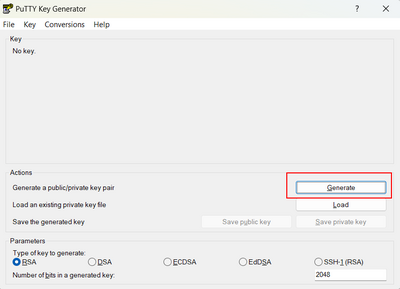Create a keypair (Advanced Console): Difference between revisions
Jump to navigation
Jump to search
No edit summary |
No edit summary |
||
| Line 4: | Line 4: | ||
== Generate a keypair == | == Generate a keypair == | ||
Begin by downloading [https://www.chiark.greenend.org.uk/~sgtatham/putty/latest.html PuTTY] and installing it onto a Windows or Mac. | Begin by downloading [https://www.chiark.greenend.org.uk/~sgtatham/putty/latest.html PuTTY] and installing it onto a Windows or Mac. This will automatically install PuTTYgen, which is a tool for creating keypairs. Open PuTTYgen, and click the 'Generate' option. | ||
[[File:Putty_Generate.png|border|400px]] | |||
Test | |||
Revision as of 16:39, 14 May 2024
This article will help you create a keypair.
Keypairs are used for authentication to cloud VMs. A keypair consists of two parts, a public key and a private key, and are specific to a single user. The following steps will explain how to create a single keypair that can be used for authentication against new Windows and Linux cloud VMs.
Generate a keypair
Begin by downloading PuTTY and installing it onto a Windows or Mac. This will automatically install PuTTYgen, which is a tool for creating keypairs. Open PuTTYgen, and click the 'Generate' option.
Test
